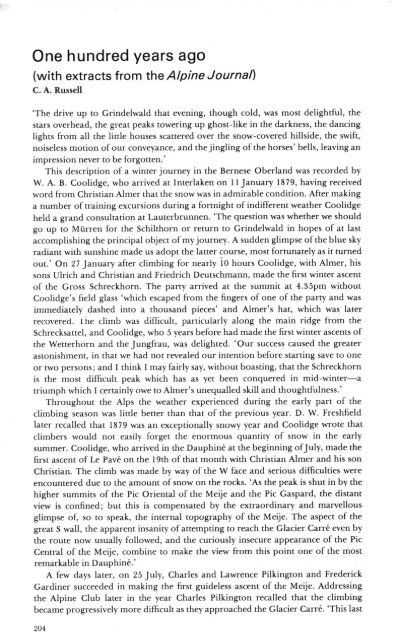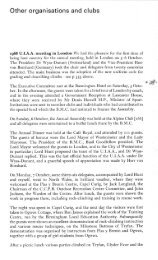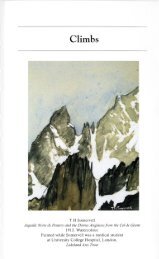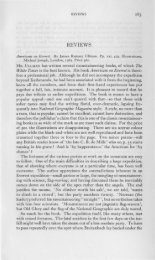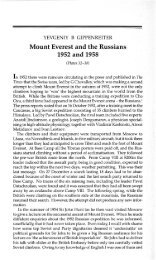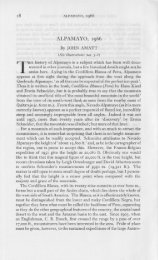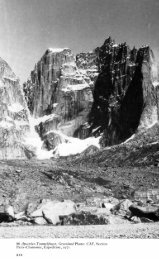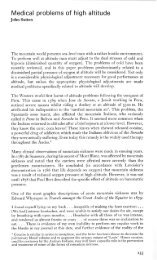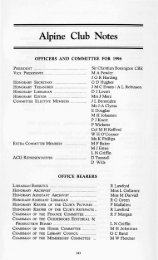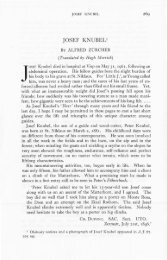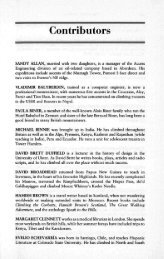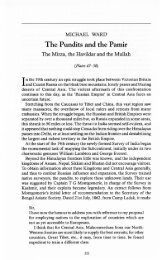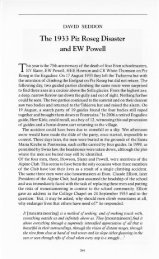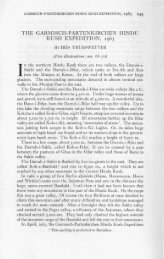One Hundred Years ago C. A. Russell 204 - Alpine Journal
One Hundred Years ago C. A. Russell 204 - Alpine Journal
One Hundred Years ago C. A. Russell 204 - Alpine Journal
You also want an ePaper? Increase the reach of your titles
YUMPU automatically turns print PDFs into web optimized ePapers that Google loves.
<strong>One</strong> hundred years <strong>ago</strong><br />
(with extracts from the <strong>Alpine</strong> <strong>Journal</strong>)<br />
c. A. <strong>Russell</strong><br />
'The drive up to Grindelwald that evening, though cold, was most delightful, the<br />
stars overhead, the great peaks towering up ghost-like in the darkness, the dancing<br />
lights from all the little houses scattered over the snow-covered hillside, the swift,<br />
noiseless motion ofour conveyance, and the jingling of the horses' bells, leaving an<br />
impression never to be forgotten.'<br />
This description of a winter journey in the Bernese Oberland was recorded by<br />
W. A. B. Coolidge, who arrived at Interlaken on 11 January 1879, having received<br />
word from Christian Almer that the snow was in admirable condition. After making<br />
a number of training excursions during a fortnight of indifferent weather Coolidge<br />
held a grand consultation at Lauterbrunnen. 'The question was whether we should<br />
go up to Murren for the Schilthorn or return to Grindelwald in hopes of at last<br />
accomplishing the principal object of my journey. A sudden glimpse of the blue sky<br />
radiant with sunshine made us adopt the latter course, most fortunately as it turned<br />
out.' On 27 January after climbing for nearly io hours Coolidge, with Almer, his<br />
sons Ulrich and Christian and Friedrich Deutschmann, made the first winter ascent<br />
of the Gross Schreckhorn. The party arrived at the summit at 4.35pm without<br />
Coolidge's field glass 'which escaped from the fingers of one of the party and was<br />
immediately dashed into a thousand pieces' and Almer's hat, which was later<br />
recovered. The climb was difficult, particularly along the main ridge from the<br />
Schrecksattel, and Coolidge, who 5 years before had made the first winter ascents of<br />
the Wetterhorn and the Jungfrau, was delighted. 'Our success caused the greater<br />
astonishment, in that we had not revealed our intention before starting save to one<br />
or two persons; and I think 1 may fairly say, without boasting, that the Schreckhorn<br />
is the most difficult peak which has as yet been conquered in mid-winter-a<br />
triumph which I certainly owe to Almer's unequalled skill and thoughtfulness.'<br />
Throughout the Alps the weather experienced during the early part of the<br />
climbing season was little better than that of the previous year. D. W. Freshfield<br />
later recalled that 1879 was an exceptionally snowy year and Coolidge wrote that<br />
climbers would not easily forget the enormous quantity of snow in the early<br />
summer. Coolidge, who arrived in the Dauphine at the beginning ofJuly, made the<br />
first ascent of Le Pave on the 19th of that month with Christian Almer and his son<br />
Christian. The climb was made by way of the W face and serious difficulties were<br />
encountered due to the amount ofsnow on the rocks. 'As the peak is shut in by the<br />
higher summits of the Pic Oriental of the Meije and the Pic Gaspard, the distant<br />
view is confined; but this is compensated by the extraordinary and marvellous<br />
glimpse of, so to speak, the internal topography of the Meije. The aspect of the<br />
great S wall, the apparent insanity ofattempting to reach the Glacier Carre even by<br />
the route now usually followed, and the curiously insecure appearance of the Pic<br />
Central of the Meije, combine to make the view from this point one of the most<br />
remarkable in Dauphine.'<br />
A few days later, on 25 July, Charles and Lawrence Pilkington and Frederick<br />
Gardiner succeeded in making the first guideless ascent of the Meije. Addressing<br />
the <strong>Alpine</strong> Club later in the year Charles Pilkington recalled that the climbing<br />
became progressively more difficult as they approached the Glacier Carre. 'This last<br />
<strong>204</strong>
106 Ridge of/he Aiguille du Chardolllu/ (Ph%: C. D. Mi/ner)<br />
precautions when on the way, they knew each other well and so could reckon<br />
confidently on each other in case of an emergency, and they had carefully studied<br />
their il1lended route beforehand so a to be quite clear on the subject.'<br />
Towards the end ofJuly thc weather became more settled and conditions began<br />
to improve. In the Pennine Alps on 30 July C. ocin with E. Peter made the first<br />
ascel1l of the Poil1le de Bricola while on I August Alft"ed Barran and F. Corbcll,<br />
with J ohann Petru and Joseph Langen, reached the summit of the Grand Cornier<br />
by way of the unclimbed SW ridge. Othcr ridges climbed for the fir t time included,<br />
in the Berne e Alp, the W ridge of the Alet chhorn on 6 August by L. Licchti with<br />
Anton Kumlller and a poneI' and. in the MOI1l Blanc range, the W ridge of the<br />
206
ONE HUNDRED YEARS AGO<br />
Aiguille du Chardonnet on I August by P. W. Thomas with Joseph Imboden and<br />
j. M. Lochmatter.<br />
Also in the Mont Blanc range, first ascents were made of the Aiguille de Talefre<br />
and the Petit Dru: the Talefl'e by F. J. Cullinan, J. Baumann and Gerald Firzgerald,<br />
with Emile Rey, Laurent Larnier and Joseph Moser on 25 August and the Petit Dru<br />
on 29 August by the Chamonix guides Jean E. Charlet-Straton, Prosper Payot and<br />
Frederic Folliguet. While the guides were climbing the Petit Dru Cullinan and<br />
Baumann, accompanied by Rey and Moser, completed the second ascent of the<br />
Grand Dru. C. T. Dent's account of the first ascent 2 was carried on the climb and<br />
found very useful.<br />
Other peaks climbed for the first time were the Punta dell'Argentera, the highest<br />
point of the Maritime Alps, and, in the Dolomites, the Cima di Canali and the W<br />
summit of the Drei Zinnen or Tre Cime di Lavaredo. The Argentera was climbed on<br />
18 August by Coolidge, with Christian Almer and his son Christian, the Cima di<br />
Canali by C. C. Tucker with Michele Bottega on 30 August and the W summit ofthe<br />
Drei Zinnen, also at the end ofAugust, by G. Ploner and M. Innerkofler..<br />
Two further climbs are worthy of note; on 12 August Paul Guillemin and A.<br />
Salvador de Quatrefages with Emile Pic made the first ascent of the NW face of<br />
Monte Viso, and in the Zermatt region on 13 August G. A. Passingham, with<br />
Ferdinand Imseng and Louis Zurbrucken, succeeded in forcing a route up the<br />
formidable, unclimbed W face of the Weisshorn. Passingham noted that the parry<br />
was greeted by a continuous barrage ofstones that 'hummed and howled through<br />
the air in a very disagreeable and spiteful manner.' This route, which ends on the N<br />
ridge a short distance from the summit, is both difficult and very dangerous; not<br />
surprisingly, few parties have repeated the climb.<br />
On the day after Passingham's climb an unfortunate accident occurred when W.<br />
O. Moseley and W. E. Craven, who had climbed the Matterhorn from Zermatt,<br />
were descending the NE ridge with their guides Peter Rubi and Christian Inabnit.<br />
Moseley, who insisted on unroping, slipped and fell; many readers will have<br />
negotiated the Moseley Slabs' on their way to the summit.<br />
In September the Matterhorn was the scene of two important climbs which were<br />
both completed on the same day; the first ascent of the NW or Zmutt ridge by A. F.<br />
Mummery, with Alexander Burgener, Johann Petrus and Auguste Gentinetta, and<br />
the ascent of the unclimbed face by William Penhall, with Imseng and Ludwig<br />
Zurbrucken. Both Mummery and Penhall had already climbed the mountain and<br />
both were certain that a route could be made either on or near the ridge, Penhall<br />
had hoped to make an attempt in August of the previous year but his plans had<br />
been thwarted by bad weather; now, on learning from Imseng that Passingham was<br />
about to turn his attention to the problem, he hurried back to the Alps, reaching<br />
Zermatt at the end ofAugust.<br />
Mummery, who had completed a successful preliminary expedition including<br />
ascents of the Fletschhorn and Portjenhorn with Burgener in August, later recalled<br />
that his previous experience ofguides 'had been chiefly, if not exclusively, with men<br />
who were eager to start on any attempt, no matter how desperate, and who were far<br />
toO polite to inquire whether their employer knew anything about the art of<br />
climbing. At an early stage in the proceedings, however, these men had invariably<br />
deyeloped a most touching, but none the less most inconvenient, affection for<br />
On 12 September 1878.<br />
Above and below the Solvay Hut at approximately 4000m.<br />
207
07 Malttrhomfrom btlow the NJau o} tht Dtnt d'HirtnJ lPhoto: AC colltction, B. R. GoodJtllow!<br />
their wives and families, and were compelled by these most commendable feelings<br />
to discontinue the ascent.'<br />
On 1 September Penhall and his guides, after reaching the last ofthe rock teeth<br />
on the ridge, bivouacked at the fOOl of the snow section, intending to complete the<br />
climb on the following day. During the night, however, the weather deteriorated<br />
and the party wa forced to descend; on the way back to Zermatt they met<br />
20
ONE HUNDRED YEARS AGO<br />
Mummery and Burgener heading for the mountain.<br />
During the evening conditions improved and after a bitterly cold bivouac<br />
Mummery and his party started to ascend the ridge on 3 September in perfect<br />
weather, using steps cut by the other party 2 days before. After negotiating the teeth<br />
they were faced with the prospect of either climbing an unpleasant-looking slope<br />
of ice and rotten rock or retreating. 'For three-quarters of an hour Burgener<br />
examined this slope without being able to see a way across it, and unpleasant<br />
doubts were being expressed when a distant jodel attracted our attention, and, far<br />
away down the mountain, we spied three dots, whom we at once and rightly<br />
guessed to be Penhall and his guides.'<br />
Penhall, who 'noticed Mummery on the arete just at the highest point we had<br />
reached two days before', had been persuaded by Imseng's promise of better<br />
weather to start again after table d'hote and was by this time on the Zmutt side of<br />
the W face well above the Tiefenmatten Glacier. For a time, with Mummery's party<br />
delayed at the gap beyond the teeth, the outcome seemed uncertain; soon,<br />
however, the Penhall party had themselves lost a valuable 2 hours by moving too<br />
far into the centre of the face.<br />
Eventually Petrus and Burgener managed to overcome the difficulties on the<br />
lower part of the ridge and, with Mummery and Gentinetta, began the detour on<br />
the W face. 'After some steady climbing we reached a point from which it appeared<br />
possible to work on to the Zmutt arete, but Burgener was somewhat doubtful, and<br />
on my telling him that Carrel had traversed this slope by a "corridor" higher Up,4<br />
he preferred to take that course.<br />
We soon gained the ledge, and found no difficulty in following it to the fault<br />
which bars access to the ridge.' While this fault was being investigated Mummery<br />
'had time to look along the ledge which winds like a pathway round all the<br />
inequalities of the mountain to the southern arete. It appeared to be quite free from<br />
snow and ice, and would not, I fancy, have offered any very serious obstacle to our<br />
traversing it.' It was later reported 5 that Mummery toldJ. P. Farrar that the 'Galerie<br />
Carrel' 'was so easy that one could stroll across it with an old umbrella!'<br />
After climbing the upper part of the ridge Mummery and his guides reached the<br />
summit at 1.45pm; the Penhall party, after scaling the edge of the W face to join the<br />
upper ridge, arrived only It hours later.<br />
Both climbs were outstanding even allowing for the fact that each party included<br />
some of the best guides of the day. While Penhall's very dangerous route has since<br />
attracted little attention the Zmutt ridge has remained one of the great classic<br />
climbs in the Alps. Mummery's route was repeated on 6 September when j.<br />
Baumann, with Petrus and Emile Rey, reached the summit at 8.45am. Baumann<br />
recorded that 'the actual climbing did not occupy more than 4t hrs., and I am of<br />
opinion that this ascent by the Zmutt arete will in future become the favourite way<br />
ofcrossing the Matterhorn for those who appreciate a good and not roo dangerous<br />
rock climb.' This has not proved to be the case, the slab section requiring dry and<br />
settled conditions to be really safe.<br />
Atter returning to Zermatt where they enjoyed 'the rewards of the faithful'<br />
Mummery and Penhall mounted a combined expedition; on 7 September, with<br />
Burgener and Imseng, they made the first recorded ascent of the Diirrenhorn.<br />
Further along the chain on 22 September Arthur Cust, with Jean Martin and Pierre<br />
4· On 17 July 1865.<br />
By Sir Edward Davidson.<br />
209
ONE HUNDRED YEARS AGO<br />
Beytrison, made the first ascent of the highest point of the Mitre de l'Eveque, between<br />
l'Eveque and Mont Collon.<br />
Towards the end of the year Edward Whymper, accompanied by J. A. and Louis<br />
Carrel, sailed from Southampton to begin his expedition lO the Andes. After<br />
arriving at Guayaquil in Ecuador an interpreter was engaged and preparations went<br />
ahead for an ascenl of Chimborazo. 6 By the end of December the party had<br />
established its second camp at approximately 5060m.<br />
This account of the events of one hundred years <strong>ago</strong> is concluded with a tribute<br />
by Coolidge which appeared in the <strong>Alpine</strong>Joumal for August 1879. 'I regretlO have<br />
to ask space to record the death ofa famous moul1laineer, the dog Tschingel, which<br />
occurred at Dorking on 16 June.<br />
Tschingel was purchased in the L6tschthal when a puppy by Christian Almer in<br />
September 1865. She made her debut as a climber by an ascent of the Torrenthorn<br />
from the Maing glacier, and a few days after crossed her first glacier pass, that from<br />
which she derived het" name. For several years she lived at Grindelwald as the<br />
watch -dog of Almer's house, and in July 1868 passed il1lo the possession of Miss<br />
Brevoon 7 and myself. In order to follow us she had perforce to climb peaks and<br />
traverse passes, and she acquitted herself so admirably that for nine summers (J 868<br />
to 1876) she was our constant companion in" our <strong>Alpine</strong> campaigns. Het" list of<br />
"grandes courses" amoul1ls to no less than fifty-five, besides numberless excursions<br />
in wil1ler and summer on glaciers and up to bivouacs, beyond which it was not<br />
judged prudent to take her. Among her more remarkable feats were Mont Blanc,<br />
MOl1le Rosa, Finsteraarhorn. Aletschhorn (twice), Nesthorn, Jungfrau from<br />
Wengern Alp, Jungfraujoch with descem to Wengern Alp, Eiger, Wetterhorn,<br />
M6nch from Wengern Alp, Ochsenhorn andJoch, and Grand Combin.'<br />
Tsch ingel also accompanied the Coolidge parry on several first ascents,<br />
including those of the Rateau and the Grande Ruine, and 'in no one instance did<br />
she ever make a false step, and very rarely required assistance.' Certainly her list of<br />
ascents is remarkable and there is something endearing in the recollection of the<br />
small dog who climbed so many high mountains.<br />
The present writer is glad that Tschingel's feats entitle her to be remembered as<br />
one of the great pioneers.<br />
210<br />
627001.<br />
Coolidge's aunt.<br />
108 Tschingel (reproducedJro71l <strong>Alpine</strong> Studies. W. A. B.<br />
Coolidge)


